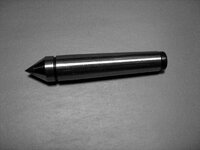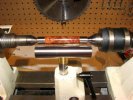John, I know that PITH and CNC have been answered but I will give you a link to a thread with other Acronyns used here:
http://content.penturners.org/articles/2009/Acronyms.pdf
. . . and I use this link to find other acronyms:
http://www.acronymfinder.com/
Now, as to your question about using standard mandrel bushings on TBC - I have a four picts posted below to show the simplicity of it.
Both custom and standard mandrel bushings are shown laid out:
Here are the custom bushings on the lathe mounted between the centers:
And Here (below) are the standard/mandrel bushings on the lathe mounted between the centers (looks the same doesn't it? - Works the same):
Compare the above layouts to the layout of a mandrel:
What it comes down to is that both kinds of bushings will work for the TBC setup. When TBC took off, custom bushings were not available so people used the standard mandrel bushings.
I will say personally that if the tolerances of commercial mandrel bushings were to be compared to custom bushings, the custom bushings would be greatly appreciated, . . . but they are not a necessity. IF using the standard bushings, I recommend that
two sets of commercial mandrel bushings be purchased and the fittings checked to get one pair that fits reasonably well.


